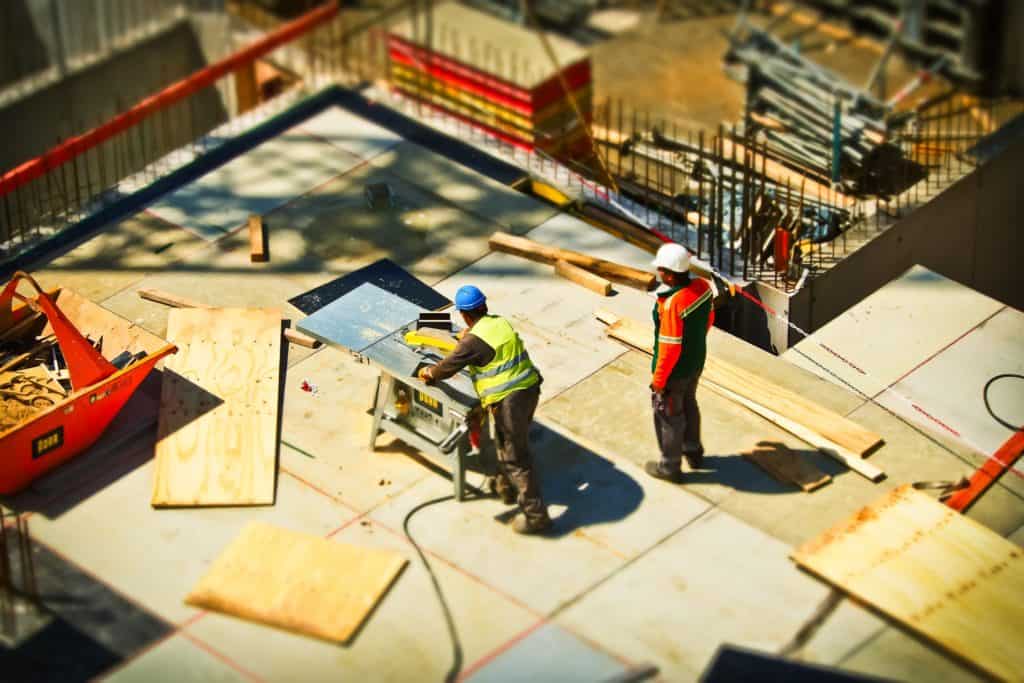When it comes to certain construction projects, waterproof materials are a must-have. If you are planning on building a structure that will be exposed to water, then you need to make sure that you are using materials that will be resistant to weather conditions. In this blog post, we will discuss 11 different waterproof building materials that can be used for construction projects. We will explain how each material is waterproof and how it can be used in your project. Let’s get started!
What building materials are waterproof?
There are many different types of building materials that can be used for construction projects. However, not all of these materials are waterproof. In order to build a structure that is resistant to water damage, you need to use materials that are specifically designed for this purpose. Here are 11 waterproof building materials you should consider.
Concrete
Concrete is one of the most common building materials in the world. In fact, over 70% of the world’s population lives in a structure that contains concrete. It’s used as a foundation for everything from roads to buildings and even sidewalks. Concrete is made by combining water, sand, gravel, cement (a powdery substance), and various additives that give it different properties. These include strength (how strong it will be under pressure), permeability (how much moisture can pass through its pores) or waterproofness.
Brick
Brick is another common building material that can be used in construction projects. It’s made of clay and other natural materials, then fired at high temperatures to give it strength and durability. Bricks are typically less expensive than concrete blocks because they require fewer resources to produce them (they don’t need water for instance). They’re also better suited for places where there isn’t much space available since bricks take up less room when stacked on top of each other than cinderblocks or stones do.
The main drawbacks with brick are its weight and the fact that it takes a long time before you can build anything from them (you have to wait until all your bricks have been burned). Because of this, most people use bricks only as a decorative accent in their projects rather than as an actual building material.
Although there are some waterproof bricks available, most aren’t because they’re made from clay which isn’t very strong or durable on its own (it needs to be fired before it can withstand water). This means that if you want something more reliable for your project then concrete might be better suited instead of brick. Read our article on Ready-Mix concrete vs site mixed concrete while you’re at it.
A few types of brick include:
- Concrete Block: A type of brick made with cement and gravel. It’s usually the cheapest option when comparing the three main types; however, it’s also heavier than both clay bricks and stone blocks so keep that in mind too!
- Clay Bricks: These bricks are created by mixing soil with other materials and then shaping them into bricks. They’re the most common type of brick and come in a variety of colors; however, they’re also the heaviest so they might not be ideal for some construction projects.
- Stone Blocks: A type of brick made from natural stones that are found near the building site. These are usually the most expensive option but they’re also very strong and durable so they can be used in place of concrete blocks in some cases.
Waterproofing additives can also be mixed into the mortar to help make it more resistant to water damage. When using brick in your project, just make sure that you use a good waterproofing mortar to seal up any cracks or spaces between the bricks themselves.
Glass
Glass can be used as both a decorative accent or structural component in construction projects. You can make it into windows, doors and even skylights with ease! Glass is very strong and durable but also has some drawbacks such as being highly reflective (which may not always work out well when you’re trying to heat your house).
The main downside of glass is that it’s expensive so if you want something more affordable then concrete might be better suited instead of brick. However, there are still ways around this; for instance, by using recycled materials from old buildings or warehouses where the price will typically drop considerably lower than what new ones would cost – especially since these days most people tend towards eco-friendly options anyway!
One type of glass that is especially good for construction projects is tempered glass. It’s made by heating and then cooling the glass quickly which makes it much stronger than regular glass. Tempered glass can be used in windows, doors and skylights without any problems and it’s also resistant to shattering (which can be a big plus if you have kids or pets running around).
When using glass in your project, just make sure that you use a good waterproofing mortar to seal up any cracks or spaces between the bricks themselves.
Steel
Iron and steel comprise about 95% of all the metal produced every year all over the world. Steel is a very strong and durable metal that can be used in construction projects. It’s often used for framing, roofing and other structural components because it doesn’t corrode or rust like some of the other metals do. The main downside to steel is its weight; it’s much heavier than aluminum or copper so keep that in mind if you’re thinking about using it in your project.
A type of steel that is especially good for construction projects is galvanized steel. Galvanized steel is coated with zinc which helps to prevent corrosion and rust from forming on the metal. This makes it ideal for use in outdoor applications where it will be exposed to the elements (such as rain, snow and sun).
Vinyl Siding
Vinyl siding is a type of plastic that is used to cover the exterior of buildings. It’s very affordable, comes in a variety of colours and styles, and is also resistant to fading and cracking.
The main downside to vinyl siding is that it can’t be painted so if you want something with a different colour then you’re out of luck. However, there are still ways around this; for instance, by using recycled materials from old buildings or warehouses where the price will typically drop considerably lower than what new ones would cost – especially since these days most people tend towards eco-friendly options anyway!
Aluminum Siding
Aluminum siding has been used not only to protect homes but also to improve their appearance since the 1930s. Aluminum was once seen as a long-lasting, cost-effective alternative to conventional wood siding during the early years. These days, vinyl siding is the most popular choice, but aluminum siding continues to be an effective way of protecting your property against Mother Nature’s elements.
Unfortunately, aluminum siding is that it can dent and scratch fairly easily. However, this can be remedied by using a good quality paint or sealant which will help to protect the metal from rusting and corroding.
Bituminous Membrane
A bituminous membrane is a waterproofing material that is made from asphalt. It’s often used in roofing and flashing applications because it’s flexible, durable and weather-resistant. Keep in mind that bituminous membrane is that it can be difficult to work with. It’s also not as fire-resistant as some of the other materials on this list.
Thermoplastic
A thermoplastic membrane is a waterproofing material that is made from polyvinyl chloride (PVC) or ethylene-propylene rubber (EPR). It’s often used in commercial buildings because it’s lightweight and extremely durable.
Thermoplastics are very expensive compared with other options on the market today. However, there are still ways around this; for instance, by using recycled materials from old buildings or warehouses where the price will typically drop considerably lower than what new ones would cost – especially since these days most people tend towards eco-friendly options anyway!
Thermoplastic membranes can be used in both flat roofs and steep slopes. These membranes are typically made from a single layer of PVC or EPR, which makes them ideal for roofs that require minimal maintenance and can withstand extreme weather conditions without cracking or splitting open during cold spells (which is important since ice dams are one of the major causes behind roof failures).
They’re also very resistant to heat and chemical damage so they’re perfect if you live in an area where there’s lots of sun exposure throughout most days each year – just make sure not to forget about applying sunscreen when necessary because these membranes still aren’t fully UV-resistant like some other materials on this list!
Thermoplastic Membrane Roofing System: Thermoplastic membrane systems usually consist of only two layers; however, they can be installed with a third layer upon request. The top part of the membrane is made out of polyester reinforcement fabric that helps to strengthen and reinforce it against punctures as well as provide protection from UV rays while still allowing water vapour transmission through its pores into your home.
The bottom portion consists mainly of PVC or EPR material which provides all-weather durability due to its ability not only to withstand high temperatures (upwards up 350 degrees Fahrenheit) but also low ones (-58 degrees Fahrenheit). These membranes are typically available in rolls between 50 – 100 feet long by 18 inches wide, however, they can come pre-cut if specified at time order placement.
Here’s a list of thermoplastic building materials to learn more.
Rubberized Asphalt
Rubberized asphalt is not a recent invention, but it has recently resurfaced in the United States. It’s made from recycled automobile tires. In order to improve the handling and workability qualities of the mix, other materials are often added to the crumb rubber. As a result, it’s a fantastic waterproof building material every contractor and developer needs to consider.
Rubberized asphalt also consumes around 220 million pounds of rubber each year, which is about 12 million tires (this figure is expected to rise). Rubber in asphalt is becoming more popular among states, with several recently developing their own techniques and processes. After all of the investigations and years of modifying procedures, the advantages are becoming increasingly apparent.
Cementitious Coating
A cementitious coating is a waterproof material that is made from Portland cement and aggregate. Cementitious coatings are used to protect concrete substrates from water infiltration and corrosion. They can also be used as a finish coat on concrete surfaces.
Polyurethane
Polyurethane is a waterproof plastic that is made from polyester resin and urethane. It can be used to seal cracks in walls or floors, as well as create water-resistant coatings.
Water-based and oil-based polyurethane is similar in appearance, although the former has a higher odour and does not dry as quickly. It comes in a variety of finishes, including glossy, and it takes on different textures depending on the application.
Water-based polyurethane is popular since it has a low odour and low toxicity. It leaves no tint or hue like oil-based versions, and it dries much faster. Water-based polyurethane, like shellac, is not durable in extreme heat or chemicals. It’s ideal for bookcases, desks, side tables, etc.
Final thoughts on waterproof building materials
The above are just a few examples of the many different types of waterproof building materials that are available today. By understanding the pros and cons of each option, you can make an informed decision about which material will work best for your specific construction project regardless of whether it’s residential or commercial. Browse our building materials shop to find the right product.

